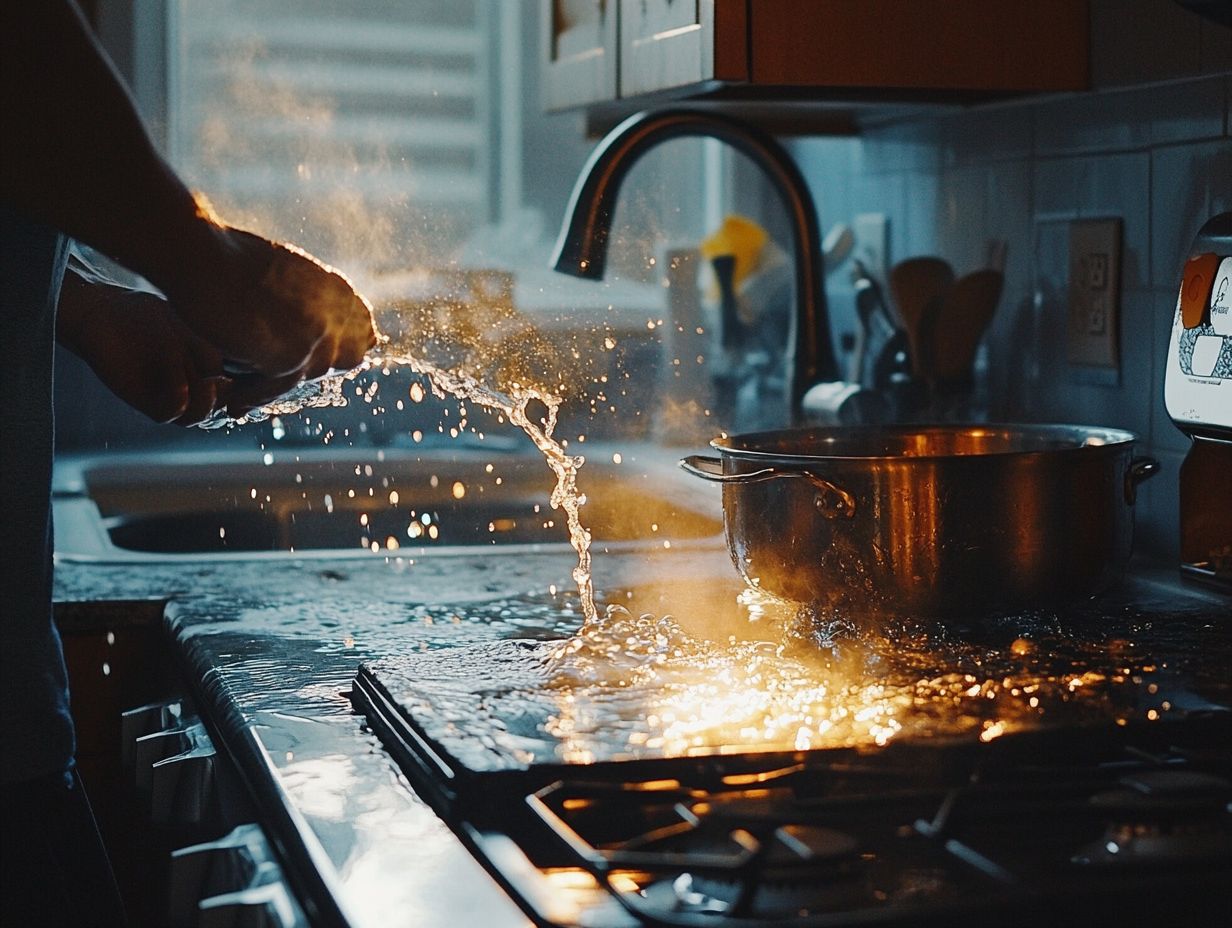What Are the Safety Rules for Cooking Near Water?
Cooking near water can elevate your experience, whether you’re lounging by a pool, soaking up the sun at the beach, or enjoying a summer cookout in your backyard. However, this delightful setting introduces unique risks that can swiftly turn enjoyment into danger.
This article delves into vital safety rules for cooking near water. It outlines essential guidelines to help you prevent accidents from burns and fires to food contamination. You’ll also find useful first aid tips and emergency resources to keep you and your loved ones secure. Stay informed and dive into your outdoor cooking adventures with excitement.
Contents
Key Takeaways:

- Be aware of potential risks when cooking near water, including burns, fires, and contamination.
- Take basic precautions, such as using long utensils and keeping a fire extinguisher nearby.
- Avoid loose clothing and never leave cooking unattended near water.
- In case of an emergency, know basic first aid tips and keep emergency contacts on hand.
The Importance of Safety Rules for Cooking Near Water
Cooking near water may seem normal. However, it has serious risks that can lead to fires or accidents. Experts from Virginia Tech and the National Safety Council emphasize understanding why safety rules matter. This understanding can significantly decrease the chances of cooking fires and enhance your overall cooking safety.
When you leave cooking unattended or neglect to install a smoke detector, even minor incidents can escalate into serious emergencies. Prioritizing fire prevention and adopting fundamental safety measures while cooking near water is essential.
Understanding the Risks
Understanding the risks associated with cooking near water is crucial for minimizing accidents and enhancing safety, particularly during activities that could spark cooking fires or grease fires.
Distractions in the kitchen like phone calls or a flickering television can lead to dire consequences. It s essential to remain vigilant, especially when working with oils or fats that can ignite if left unattended.
Maintaining the right food temperatures is not just about cooking; it s also about preventing the growth of harmful bacteria. When food lingers in the temperature danger zone between 40 F and 140 F it becomes vulnerable to spoilage and foodborne illnesses. Therefore, managing heat sources effectively can significantly lower these risks.
General Safety Guidelines

Establishing comprehensive safety guidelines is essential for creating a secure cooking environment, particularly near water, where the potential for accidents is increased.
Basic Precautions to Take
Basic precautions can significantly reduce the likelihood of accidents in your kitchen, especially when using cooking appliances near water. This is vital when handling raw meat and other food safety concerns.
Keeping raw meat separate from other ingredients is essential to avoid cross-contamination, which can lead to foodborne illnesses. Store cold food items at the correct temperatures to prevent spoilage and health risks. Also, avoid overloading cooking appliances, as it can lead to malfunctions or fire hazards.
By implementing these safety measures, you minimize the risk of accidents and injuries while creating a safer cooking environment that enhances your culinary experiences.
Specific Safety Rules for Cooking Near Water
Implementing specific safety protocols for cooking near water is crucial to prevent accidents, particularly those involving grease fires or other kitchen hazards. For more information, check out safety tips for open flame cooking that can help protect life and property.
Taking these precautions ensures a safer cooking environment and protects what matters most.
Preventing Burns and Fires

Preventing burns and fires in the kitchen demands your unwavering attention, especially when using cooking appliances near water. This increases the risk of grease fires and other hazards.
Implement various strategies to ensure your safety. Using oven mitts may seem simple, but it effectively guards your hands against hot surfaces, providing a necessary barrier against heat.
Keeping your cooking appliances in top-notch condition significantly decreases the chance of accidents. Worn-out equipment can malfunction, leading to potentially hazardous situations.
Equally vital is installing smoke detectors. These act as your early warning system for potential threats. Regularly check these devices and respond promptly to alarms to maintain a proactive approach to kitchen safety.
Avoiding Contamination
Avoiding contamination is crucial for cooking safety, especially preventing the mixing of raw meat with other foods, which can lead to foodborne illnesses.
Prioritize keeping your hands clean. Thoroughly washing them with soap and water before and after handling food is non-negotiable.
Employ proper food storage practices. Ensure raw ingredients are stored at the correct temperatures and kept separate from cooked items to minimize any risk of bacteria spreading.
Utilize refrigerants that keep your ingredients within safe temperature ranges. Consistently monitor leftovers to further safeguard your culinary endeavors.
By implementing these practical steps, you can create a safe and healthy kitchen environment, significantly reducing the chances of food-related diseases.
What to Do in Case of an Emergency
Being prepared for emergencies while cooking is vital. Quick actions can make a real difference in cooking fires or other incidents.
Planning ahead enhances your safety and makes cooking more enjoyable.
First Aid Tips

First aid tips are essential for addressing minor injuries that can occur while cooking, especially burns from hot appliances or spills.
Understanding how to respond effectively can truly make a difference in the healing process. Cooling a burn under lukewarm water for at least 20 minutes can significantly reduce skin damage.
If you cut yourself while chopping, it s vital to clean and dress the wound promptly to prevent infection.
It’s wise to keep a well-stocked first aid kit nearby, including essentials like:
- Sterile bandages
- Burn creams
- Antiseptics
By practicing safe cooking habits and staying aware of potential hazards, you minimize the risk of injuries and contribute to overall kitchen safety and fire prevention.
Emergency Contacts and Resources
Having emergency contacts and resources readily available is crucial for effectively responding to incidents while cooking, especially regarding fire prevention and safety protocols.
Knowing whom to call in an emergency can make all the difference. Have important numbers, like 911 for immediate emergencies, prominently displayed in your kitchen.
List contacts for local fire departments, poison control, and trusted neighbors to add another layer of security. For further insights on cooking safety, resources from organizations like the National Safety Council are invaluable. Consider keeping this information on a magnet or a bulletin board where it s easily visible.
Staying Safe While Cooking Near Water
Staying safe while cooking near water requires a careful blend of watchfulness, proper appliance use, and a commitment to fire prevention strategies.
It’s crucial to regularly inspect your appliances for any signs of damage or wear to ensure they operate safely. Keeping electrical devices away from sink areas significantly reduces the risk of electric shock.
Be mindful of flammable items like towels and paper products to ensure they remain at a safe distance from the stove and other heat sources. Promoting mindfulness among family members during cooking creates a culture of safety.
By incorporating these straightforward yet impactful kitchen safety tips, you can create a safe cooking space quickly and easily!
Frequently Asked Questions
Top Safety Tips for Cooking Near Water!
- Always make sure to have a fire extinguisher and first aid kit nearby in case of any accidents.
- Keep a safe distance from the water source while cooking to avoid any splashing or steam burns.
- Never leave any cooking equipment or open flames unattended near the water.
- Use non-slip mats or stable surfaces to prevent any slipping or tripping into the water.
- Avoid wearing loose clothing and tie back long hair to prevent them from catching fire while cooking near water.
- Be aware of potential hazards in the water, such as strong currents or underwater obstacles, and avoid cooking in those areas.
Following these tips can help ensure a safe and enjoyable cooking experience near water.




